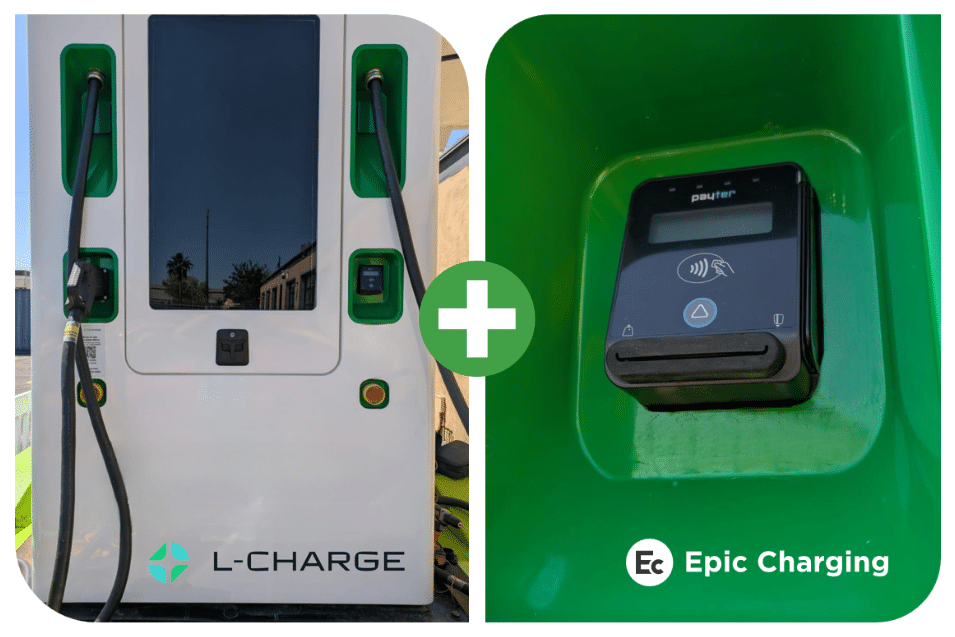L-Charge and Epic Charging Installed Grid-Free Hybrid Public and Fleet Charging Site in Days
In a market where electric vehicle adoption is surging faster than utility infrastructure can keep up, L-Charge and Epic Charging have partnered to offer a turnkey, ultra-fast EV charging solution that requires no utility connection. Together, they deployed an off-grid hybrid charging site powered by low-carbon fuels and managed entirely through Epic’s OCPP 2.0.1 software platform. The new installation supports both commercial fleets and public EV drivers at a highly trafficked urban location — all without waiting for grid access or a long permitting process.
The location itself faced a significant challenge. Positioned in a busy metro area with strong demand for EV charging, the site had zero available grid capacity. Getting a conventional setup permitted, engineered, and powered could have taken months, delaying electrification goals and leaving public EV drivers without a nearby option. The owner needed a ready-made solution that could go live immediately, serve their own fleet as well as visiting drivers, and bypass the delays inherent in utility coordination.
L-Charge supplied ultra-fast off-grid chargers fueled by renewable natural gas and flare gas, allowing the station to come online in a matter of days without any utility approvals. Epic Charging handled the entire charge point management platform via its OCPP 2.0.1 software, making real-time monitoring, remote diagnostics, and integrated payment acceptance seamless. Drivers can pay on the spot with a credit card or via Epic’s mobile app, a seamless integration with Payter credit card readers — without creating accounts — while fleet operators can track every session through a robust, future-proof dashboard.
For fleet managers and commercial operators, this kind of rapid deployment is a game-changer. The station went live in under a week with no utility lead time, so there was virtually no wait to begin operations. The flexible Charging-as-a-Service model meant the client avoided big up-front capital expenses, paying only for the energy consumed. Thanks to ultra-fast DC charging and a design built for mixed-use fleets and public drivers, the station maximizes its earning potential while meeting diverse charging needs — whether for cars, vans, trucks, or buses.
More importantly, this project proves that going electric doesn’t have to be hamstrung by grid constraints. The operator began supporting their fleet immediately while also generating revenue from public EV drivers in an area that previously had no practical options. What could have been a long, expensive utility project became a fully functioning asset practically overnight — one that scales as demand grows and integrates easily with future software enhancements.
This deployment matters because it highlights a new path for EV adoption. Instead of waiting years for grid upgrades, companies can meet today’s needs in a matter of days — serving both operational and public customers without the usual risks or delays. It also means every diesel mile that’s displaced happens now, not in some far-off future, helping accelerate the shift to cleaner, more sustainable transportation.

Why the Length of Time to Install EV Charging Is a Problem
One of the biggest barriers to widespread EV adoption isn’t just the cost of the car — it’s the slow pace of getting new charging stations up and running. Installing EV charging requires a complicated process: obtaining permits, utility approvals, equipment lead times, site construction, and electrical upgrades. This process can take months, and sometimes more than a year for larger projects.
That kind of delay is a real issue for drivers and businesses alike. EV drivers need convenient, reliable places to charge, and long wait times for new stations mean charging deserts persist in areas that need them most. On the business side, companies that want to attract EV customers or transition to electric fleets can’t scale quickly enough if the infrastructure lags.
The long installation timeline also discourages property owners and investors from committing to new EV projects. If a station takes too long to become operational, the economics can look uncertain, and potential revenue — or environmental benefits — get pushed further into the future.
In short, the slow installation process is a serious bottleneck. To support the growing number of EVs on the road and meet sustainability goals, we need faster, more streamlined ways to build out the charging network — or risk falling behind as demand outpaces supply. L-Charge and Epic Charging have solved that problem.
For more, visit www.epiccharging.com and www.l-charge.net
